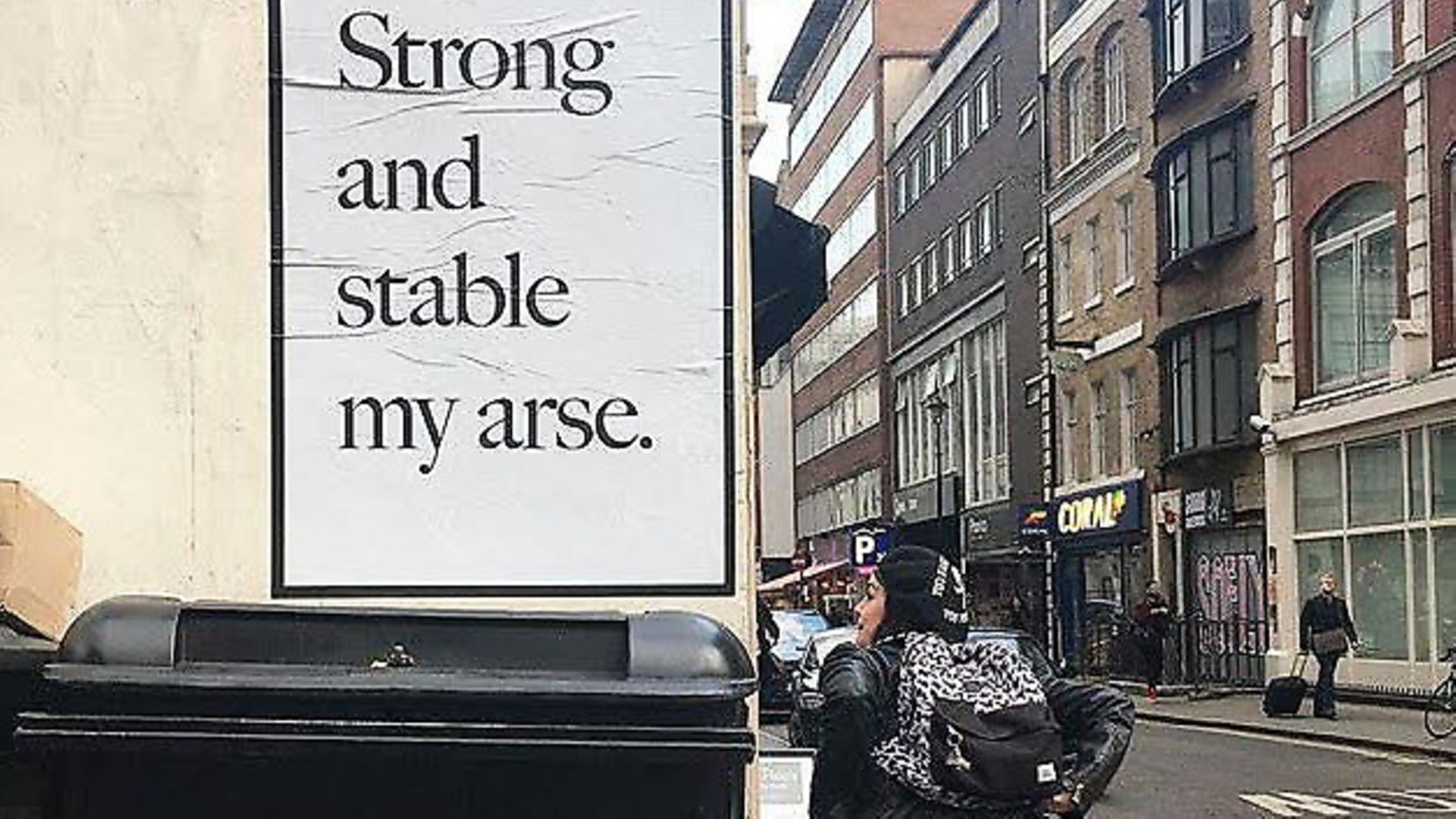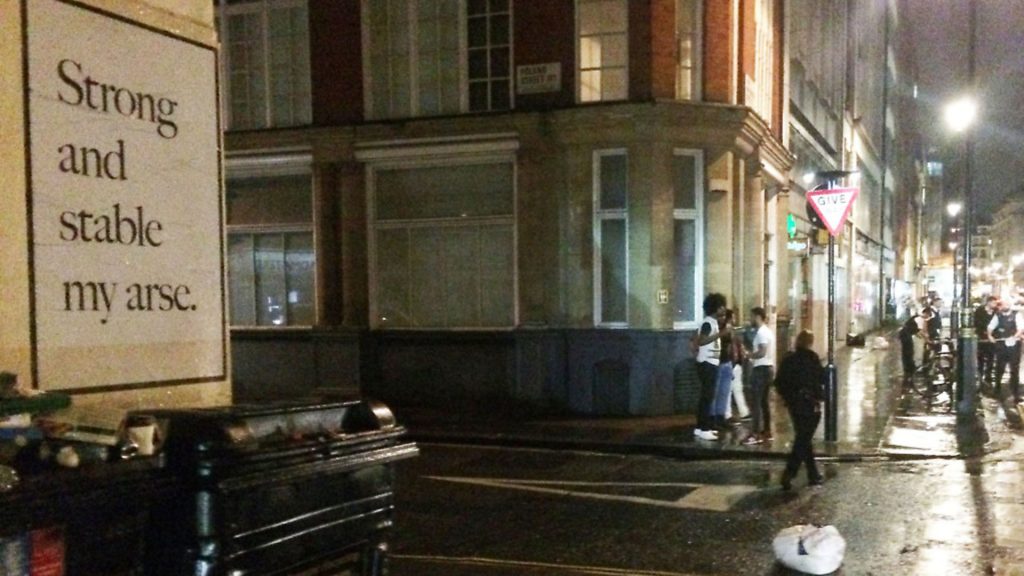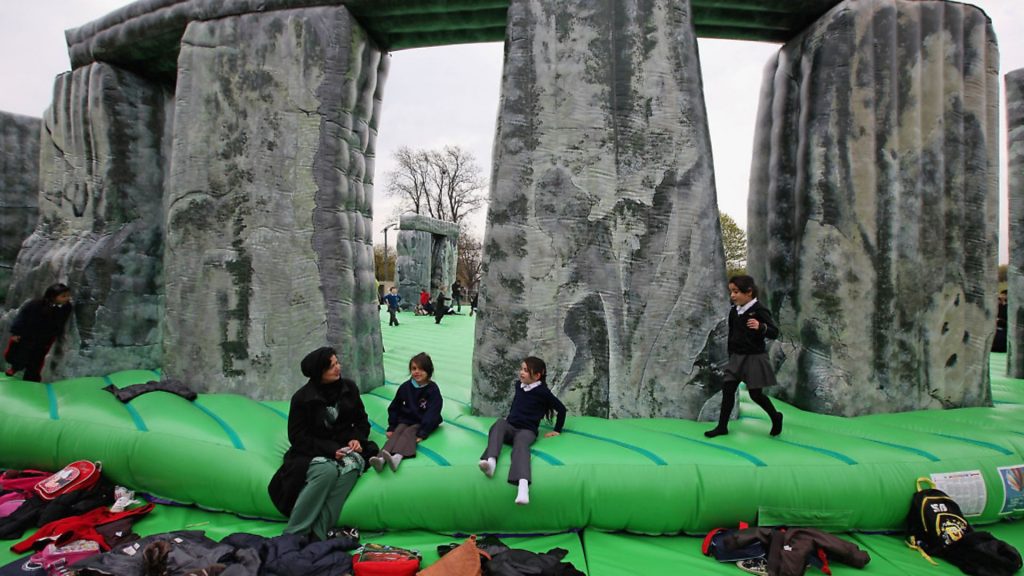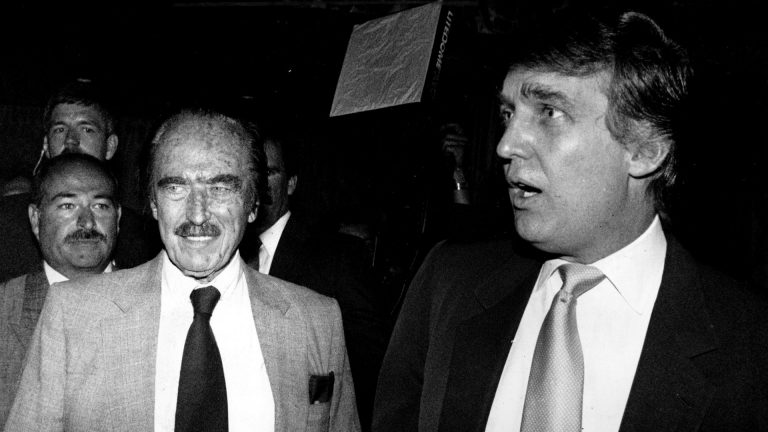
In his work, Jeremy Deller’s has taken inspiration from an array of subjects… right up to the Prime Minister’s latest vapid soundbite.

As Jeremy Deller was being shown round Stonehenge its custodians were unaware his intention was to make a ‘bouncy castle’ replica of the late Neolithic monument. When official backs were turned PVC swatches were surreptitiously held up against the sandstone sarsens and bluer igneous rock in an attempt to arrive at satisfactory colour matches. The original subterfuge being well worth it when you saw what tumbling joy Sacrilege (2012) bought to huge numbers of people as it toured the country.
A significant strain of Deller’s extensive body of work revisits the monumental, the mythological and regenerates it so presumed fixities in material and symbolic terms might be questioned. Maybe, as well as the performance of solemn rites, there was fun to had on that plain in prehistoric Wiltshire, if not bouncing then at least a great game of hide-and-seek. Deller brings back to life, restores to the public realm a site that seemingly in recent years has been ever more commodified, sold back to the public in aspic, on terms dictated by tourism and profit.
But it’s not just the distant past that the artist has drawn on for inspiration. A work for which the 2004 Turner Prize winner first became more widely known is The Battle of Orgreave (2001). This involved a re-enactment of the bitter 1984 conflict between police and striking miners: a violent culmination of a decades long ideological battle between successive governments and the British trades union movement.
It was in his late teens that Deller first saw news footage of the brutal events of June 18, 1984 and remembered thinking: ‘There’s something seriously wrong with this country if this is what we have to do to people.’

Nearly a 1,000 folk took part in Deller’s reenactment. And the work is as much about the participants – some were miners or related to miners present at the original fracas – as it is a prompt to considering what happened subsequently. A coming together of people who had lived through recent history yes, but hardly cathartic, more like (ironically) a police reconstruction of events relevant to a serious crime.
Deller challenges buried histories, brings unresolved issues to light. This is no exercise in healing but rather confronting something unresolved, bringing it back into discussion. Reminding us of the trauma of individuals, families and communities affected. ‘There’s no way you can recreate a 20,000 person riot but you can resurrect a version of it,’ explained the artist. It opened up wounds that have been sunk by subsequent shifts in ideology. But there’s also humour, a comedic absurdity as well as the very serious intent to challenge establishment cant.
In Mike Figgis’ film about Deller’s reenactment Tony Benn revealed how the BBC has always been a tool of the state. Journalists’ footage of the battle near Orgreave coking plant showed that miners threw rocks only after a police ‘cavalry’ charge. When it was aired on television events had been edited, turned around to suggest it was miners who struck first. The BBC later claimed that the re-constructed truth (a lie) was an inadvertent mistake. Something not dissimilar appears to be happening with some of the current election campaign coverage.
So much contemporary, socially engaged art wants ‘the world to be a better place’ but Deller is neither confident in nor satisfied by such a pat answers. While emphatically oppositional the artist is never didactic, thereby avoiding the straitjacket of some politically inclined artworks. Instead, through what’s been termed his ‘curation of the improbable’ Deller opens up and encourages debate, invites multiple viewpoints.
Admittedly the artist’s practice sees him introducing what by his own admission are sometimes quite blunt instruments into the public domain. Deller wants to rile people, get them angry, to challenge how things stand and through a bringing together of disparate points of view and the people who hold them have a tangible social impact. The artists’ role in society is to be ‘always a bit of a troublemaker. They fight with ideas and imagery […] of course there’s artists who make beautiful things and that’s fine but that’s not where my focus is.’
Take Deller’s Baghdad, 5th March 2007 (2010), in physical terms the work consists of the rusted, mangled remains of a vehicle caught up in a car bomb blast that destroyed an Iraqi street book market.
It’s a formidable object, symbolising the vulnerability of the human body and a memorial to the dozens of people killed on that fateful ‘everyday’ in a war torn city: a sobering reminder of the impact of modern war on civilians.
Aesthetically, materially it is gruesome and fascinating. Some artists might be satisfied just to have come by this found object plucked from the morass of a very messy conflict. Its power as an index of violence is plangent. But Deller is never content with making a visual blast. He took the artefact on tour. There are artists who make ‘trophy objects’ and others who create experiences.
The potential for conflict while travelling across the US with such a potent wreck was glaring. Making art in this way you really have little or no control over the weather, how people will react. On the road it could have become a farce, it could have turned nasty in a country that is much more overtly militaristic and gun-loving. It was an exciting if somewhat dangerous way to proceed.
Having the courage to ‘risk’ meaningful, honest, open relations with ‘ordinary’ people as well as specialists was something Deller learnt early on with Acid Brass (1997) and the positive outcome of which was something of a jumping-off point for subsequent endeavours – if you are clear and straight with people much of the time they will respond positively in kind.
Deller discerns a difference between art and activism. The Baghdad car wasn’t an anti-war protest, again rather it was an attempt to provoke much wider considerations and reflection. If the car had only been shown in an art gallery then it would have lost some of its testimonial aspect and become an object appreciated for its formal qualities: its shape, colour, texture…
The artist doesn’t hold much truck with that reading. Deller’s said that after towing the work across America – together with an Iranian and US soldier – again it was the prompting of numerous discussions amidst potentially risky encounters, reactions, that proved to be the salient meaning or value of the work. And now its permanent exhibition at the Imperial War Museum avoids it being bracketed out as an art object rather than a document of conflict.
More recently Deller’s We’re Here Because We’re Here (2016) saw soldiers appear in mundane situations – transport hubs, shopping malls, Ikea – dressed in First World War uniform across the UK to mark the centenary of the Battle of the Somme. These apparitions of the dead engaged with but didn’t talk to 21st century passersby. If any member of the public appeared to show an interest they were simply handed a card bearing a real First World War combatant’s name, their role and age at death. Seeing the ‘dead’ walk the streets (a phenomena understandably reported by loved ones as really happening after the war) caused a gamut of emotion in 2016 from bemusement to tears.
Deller likes to take his art somewhere awkward, not awkward for awkward’s sake, but somewhere that’s tough and unsentimental, an imaginary of various troubling situations that can be so easily papered over by subsequent events.
That the artist’s ‘toolkit’ of media and approaches to work can make people cry, laugh and be genuinely afraid is pertinent because there are so many reasons to be affected by what’s going on at local, national and international levels today.
Our consciences should – must – be pricked at times. We deserve much more than the oftentimes patronisingly simple, binary choices on offer. We deserve better than politicians stabbing each other in the back, lying to us. Deller’s work refutes the carping sophistry of silver-tongued corrupt individuals and power blocs who sacrifice ethical social concern for the sake of their careers and vested interests of which they are often the direct beneficiaries.
A current work by Deller is a plain and simple street intervention. Appearing on hoardings around the country: a black and white poster bearing the words ‘Strong and stable my arse’.
‘Strong and stable’ is a stock phrase, of course, and has become gratingly all the more so since Theresa May’s flip flop snap election. Deller’s unfussy black lettering on a white ground is a design knowingly spartan. That is ‘showing or characterized by austerity or a lack of comfort or luxury.’ Sounds familiar. Together with its somewhat melancholy ‘black bordered tell of grief’, as Dickens had it, the work resonates with the ‘just about managing’ state of the nation.
Because so many aren’t managing, not without charity and as Mary Wollstonecraft noted: ‘It’s justice not charity that is wanting in this world.’ And Deller’s pièce de résistance maybe somewhat base but at the same time it’s pure gold. That terse, defiant and disapproving ‘my arse’ appended to May’s glib attempt at verbal con trick.
‘Grapefruit my arse’, ‘Bono my arse’, ‘Feng Shui my arse’… ‘Strong and stable my arse.’ Where’s Ricky Tomlinson? We need him voicing Deller’s phrase twenty-four seven, to counter what is often proving to be mainstream media’s rank and insidious election coverage.
Adrian Burnham writes on art and urban culture. He is founder and curator of www.flyingleaps.co.uk a street poster and web platform for artists. Email him at ade@flyingleaps.co.uk or info@flyingleaps.co.uk









